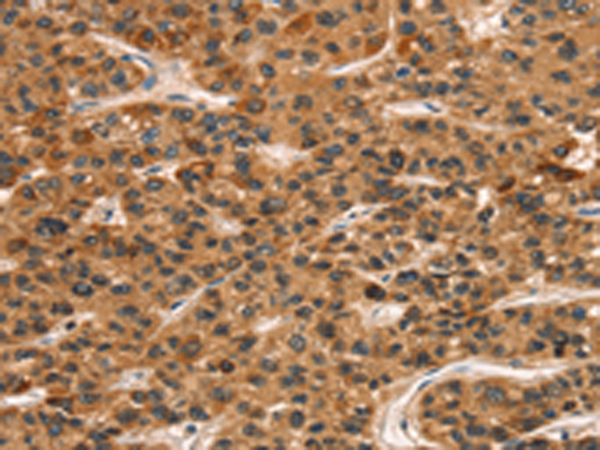

| WB | 咨询技术 | Human,Mouse,Rat |
| IF | 咨询技术 | Human,Mouse,Rat |
| IHC | 1/50-1/200 | Human,Mouse,Rat |
| ICC | 技术咨询 | Human,Mouse,Rat |
| FCM | 咨询技术 | Human,Mouse,Rat |
| Elisa | 1/2000-1/5000 | Human,Mouse,Rat |
| Aliases | NKG2; NKG2A; CD159A |
| Host/Isotype | Rabbit IgG |
| Antibody Type | Primary antibody |
| Storage | Store at 4°C short term. Aliquot and store at -20°C long term. Avoid freeze/thaw cycles. |
| Species Reactivity | Human |
| Immunogen | Fusion protein of human KLRC1 |
| Formulation | Purified antibody in PBS with 0.05% sodium azide and 50% glycerol. |
+ +
以下是关于KLRC1抗体的3篇参考文献及其摘要概括:
---
1. **标题**: *"NKG2C+ NK cells are enriched in lymph nodes of HIV-infected controllers"*
**作者**: Hernández JC, et al.
**摘要**: 该研究通过流式细胞术结合KLRC1(NKG2C)抗体,分析了HIV控制者淋巴结中NK细胞亚群的分布。研究发现,KLRC2C+ NK细胞在病毒控制者中显著扩增,提示其可能通过HLA-E相互作用参与抗病毒免疫应答。
---
2. **标题**: *"Adaptive NKG2C+ NK cells mediate pathogen-specific recall responses"*
**作者**: Beziat V, et al.
**摘要**: 本文利用KLRC1抗体阻断实验,揭示了NKG2C+ NK细胞在巨细胞病毒(CMV)再激活时的记忆样功能。研究证明,KLRC1抗体可抑制NK细胞对CMV感染细胞的杀伤,表明NKG2C受体在适应性免疫中起关键作用。
---
3. **标题**: *"Targeting NKG2C enhances anti-tumor immunity in HLA-E-positive cancers"*
**作者**: Adams NM, et al.
**摘要**: 该研究通过KLRC1抗体阻断和激活实验,探讨NKG2C在肿瘤免疫治疗中的应用。结果显示,KLRC1抗体可增强NK细胞对高表达HLA-E的肿瘤细胞的杀伤能力,为癌症免疫治疗提供了新靶点。
---
这些文献涵盖了KLRC1抗体在病毒感染、适应性免疫及肿瘤治疗中的研究,展示了其在功能分析和临床转化中的应用价值。
The KLRC1 gene encodes NKG2A, a transmembrane protein belonging to the C-type lectin-like family, primarily expressed on natural killer (NK) cells and a subset of cytotoxic T cells. As an inhibitory receptor, NKG2A forms heterodimers with CD94 to recognize the non-classical MHC class I molecule HLA-E. This interaction delivers suppressive signals that regulate immune cell activity, preventing excessive cytotoxicity and maintaining immune homeostasis. KLRC1 antibodies are critical tools for studying NK/T cell function, immune evasion mechanisms in cancer, and viral infections (e.g., HIV, CMV) where pathogens upregulate HLA-E to evade detection.
In research, anti-KLRC1 antibodies enable flow cytometry-based immunophenotyping, immunohistochemical staining of tissue samples, and functional studies blocking NKG2A-CD94/HLA-E interactions. They’re pivotal in exploring therapeutic strategies, particularly in oncology, where NKG2A blockade is investigated to enhance antitumor immunity. Clinical-stage inhibitors like monalizumab (anti-NKG2A) exemplify translational applications, showing promise in combination therapies with checkpoint inhibitors. Structurally, these antibodies often target extracellular domains of NKG2A, requiring careful validation for specificity due to homology with other NKG2 family members (e.g., NKG2C). Current studies also focus on KLRC1 polymorphisms linked to disease susceptibility, emphasizing its dual role in protective immunity and pathological tolerance.
×